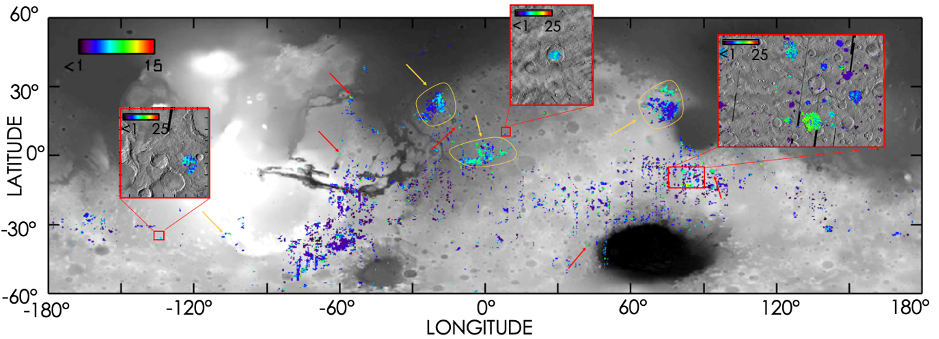Estimation of H2O content (in wt%) stored in hydrated silicates at Mars and implications for In Situ Resource Utilization (ISRU)
- 1European Space Agency (ESA), European Space Astronomy Centre (ESAC), Camino Bajo del Castillo s/n, 28692 Villanueva de la Cañada, Madrid, Spain
- 2Institut d’Astrophysique Spatiale (IAS), Université Paris-Saclay, Orsay, France
- 3Laboratoire d’Astrophysique de Marseille (LAM), Marseille, France
In the past decades, numerous hydrated silicates have been detected at the surface of Mars from orbital and in situ characterization. Understanding the hydrated mineralogy of Mars constitutes an important goal to retrace its water history and to evaluate its resource assets in terms of water budget. In addition to providing information on the past aqueous subsurface and surface environments, the aqueous alteration minerals (e.g., secondary phases) have a major exobiological potential and are prospective resources for human exploration and in situ resource utilization (ISRU, [1]). As such they are key drivers in the selection of current and upcoming landing sites for robotic and human missions to Mars. With a more global and quantitative view of the altered mineralogy (as presented in [2]) the modal composition can be accessed and the water content stored in hydrated silicates present at/near the surface can be evaluated. By quantifying the content of each minerals at the hydrated sites, the estimation of the water content stored at the surface within these minerals is then quite straightforward. The global mineralogical maps of [2] were used. They were derived using the full dataset of the OMEGA instrument, where the global abundances of 11 hydrated silicates can be found: Fe-Mg dominated smectite, Al-smectite, AlSiOH, Opal, Mg-carbonates, Chlorite, Fe/Mg-Micas, Serpentine and Fe-hydroxide. A set of non-hydrated minerals is also included in the mixture but is not used to derive the water content as they do not contain OH or H2O. To evaluate the water content of each individual end-member, the potential chemical formula of each end-member was first evaluated and then the weight percent of H2O or OH in the formula was estimated. This methodology is based on [3]. Thus, for each end-member several estimations of the water content are computed. They depend on the selected formula (the exact formula being unknown at Mars) and on the estimated hydration state (being also unknown) of each mineral. Then, the abundance of each end-member in water content is evaluated by multiplying their abundance with their individual water weight percent and by summing at each location (i.e., each pixel of the map) all the resulting water contributions. The resulting global map of water content at a resolution of ~ 1 km per pixel at the equator is shown on Figure 1.
The average content of water, based on the content stored in hydrated silicates, is estimated to be slightly above 5 wt%, with some rare occurrences > 20 wt% (examples of such occurrences are shown on Figure 1). These values are in good agreement with previous orbital estimations of the water content at Mars based on other estimations techniques ([4],[5]) that predicted 2-7 wt% on average at the surface.

Figure 1 - Global map of water content (wt%) at Mars, as stored in hydrated silicates. The red arrows point at location of 100s km2 were the water content at the surface is consistently > 10 wt%. Three zoomed maps are shown to illustrate specific settings that provide a high-water content at the surface. The orange arrows and circles highlight the large deposits of Marwth Vallis, Nili Fossae and Meridiani Planum.
The ongoing studies now aim at a detailed analysis of the water distribution in order to look for new regions with high past aquability (stable liquid water) potential and/or exobiological potential, if such locations exist. The map will be studied locally (see Figure 1) in combination with high resolution images in order to correlate the high-water content with their context and highlight new regions of interest. Incorporation of ground-truth knowledge from Perserverance at Jezero crater is foreseen so as to refine the mineral endmembers, and make abundance comparisons on the larger mineral units which will be sampled.
References
[1] Abbud-Madrid, A., et al. (2016). Mars Water In-Situ Resource Utilization (ISRU) Planning (M-WIP) Study 90.
[2] Riu, et al. (2022). The M3 project: 3 – Global abundance distribution of hydrated silicates at Mars. Icarus 374, 114809. https://doi.org/10.1016/j.icarus.2021.114809
[3] Wernicke, L.J. & Jakosky, B.M. (2021). Martian Hydrated Minerals: A Significant Water Sink. J. Geophys. Res. Planets 126. https://doi.org/10.1029/2019JE006351
[4] Audouard, J., et al. (2014). Water in the Martian regolith from OMEGA/Mars Express: Mars 3 µm absorption and water mobility. J. Geophys. Res. Planets 119, 1969–1989. https://doi.org/10.1002/2014JE004649
[5] Milliken, R.E. et al. (2007). Hydration state of the Martian surface as seen by Mars Express OMEGA: 2. H 2 O content of the surface: HYDRATION STATE OF THE MARTIAN SURFACE. J. Geophys. Res. Planets 112. https://doi.org/10.1029/2006JE002853
How to cite: Riu, L., Carter, J., and Poulet, F.: Estimation of H2O content (in wt%) stored in hydrated silicates at Mars and implications for In Situ Resource Utilization (ISRU), Europlanet Science Congress 2022, Granada, Spain, 18–23 Sep 2022, EPSC2022-132, https://doi.org/10.5194/epsc2022-132, 2022.

